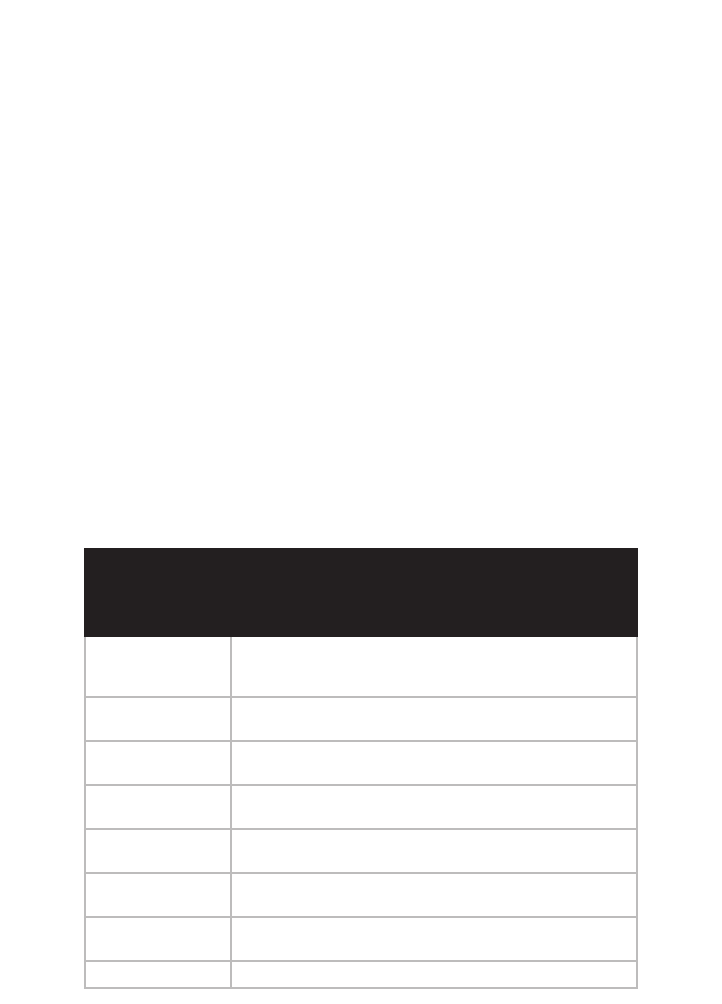
Cooking Accessories
(not included with
Microwave)
Remarks
Plastic containers
Use microwave-safe containers only. Follow the manufacturer’s instructions.
Containers should be labeled “Microwave-Safe.” Some plastic containers soften
as the food inside gets hot. “Boiling bags” and tightly closed plastic bags
should be slit, pierced, or vented as directed by package.
Plastic wrap
Microwave-safe only. Use to cover food during cooking to retain moisture.
Do not allow plastic wrap to touch food.
Wax paper Use a cover to prevent splattering and to help retain moisture.
Materials to Avoid in a Microwave Oven
Cooking Accessories
(not included with Microwave)
Remarks
Aluminum pan or tray May cause arcing. Transfer food into microwave-safe dish.
Food carton with metal handle May cause arcing. Transfer food into microwave-safe dish.
Metal or metal-trimmed utensils
Metal shields the food from microwave energy and may cause
arcing.
Metal twist ties May cause arcing and could cause a fire in the oven.
Plastic foam
Plastic foam may melt or contaminate the liquid inside
when exposed to high temperature.
Wood
Wood will dry out and may split. Avoid using wooden containers
or utensils in the oven.
The microwave oven has an electronic tube called a magnetron that produces microwaves, very short radio
waves. The microwaves then pass through a wave-guide and into the oven cavity. The microwaves penetrate the
food and cause water molecules within the food to vibrate extremely rapidly. This vibration causes considerable
friction or heat between the water molecules resulting in a rapid rise in temperature. This type of heating is very
efficient and the cooking time is therefore shorter than in a conventional oven. The rate of heating depends on
the moisture content, shape, volume, and amount of food present. Metallic materials totally reflect microwaves.
Non-metallic materials such as glass, paper, and plastics are partially transparent to microwaves. Microwaves
do not directly heat the oven walls and most cooking utensils because they do not absorb microwave energy.
However, they frequently get very warm through being in direct contact with hot food.
5
Grounding Instructions
This appliance must be grounded. In the event of an electrical short circuit, grounding reduces the risk of electric
shock by providing an escape wire for the electric current. This appliance is equipped with a cord having a ground-
ing wire with a grounding plug. The plug must be plugged into an outlet that is properly installed and grounded.
WARNING: Improper use of the grounding can result in a risk of electric shock.
Consult a qualified electrician if the grounding instructions are not completely understood,
or if doubt exist as to whether the appliance is properly grounded.
• Do not use an extension cord. If the power supply cord is too short, have a qualified
electrician install an outlet near the appliance.
Testing Containers and Utensils
Some non-metallic containers and utensils become extremely hot when used in a microwave oven. To avoid
risk of scalding, use the following procedure to determine if a container or utensil is safe for microwave use:
1. Fill a microwave-safe container with 1 cup (250 ml) of cold water. Place it in the microwave oven
along with the container or utensil in question.
2. Turn the oven on maximum power for 1 minute. Do not exceed 1 minute cooking time.
3. Carefully feel the container. If the empty container is warm, do not use it for microwave cooking.
Materials You Can Use in a Microwave Oven
Cooking Accessories
(not included with
Microwave)
Remarks
Aluminum foil
Shielding only. To prevent overcooking, use small, smooth pieces to cover
the thin areas of meat or poultry. Arcing can occur if the foil is too close
to the oven walls. The foil should be at least 1 inch away from oven walls.
Dinnerware
Microwave-safe only. Follow manufacturer’s instructions. Do not use cracked
or chipped dishes.
Glass jars
Always remove lid. Use only to heat food until just warm. Most glass jars
are not heat resistant and may break.
Glassware
Heat-resistant oven glassware only. Make sure there is no metallic trim.
Do not use cracked or chipped dishes.
Oven cooking bags
Follow manufacturer’s instructions. Do not close with metal tie. Make slits
to allow steam to escape.
Paper plates
Use microwave-safe plates only for short-term cooking/warming only.
Do not leave oven unattended while cooking.
Paper towels
Use microwave-safe paper towels only to cover food for reheating and absorbing
fat. Use with supervision for short-term cooking only.
Parchment Use as a cover to prevent spattering or a wrap paper for steaming.
4
How Your Microwave Oven Works


















